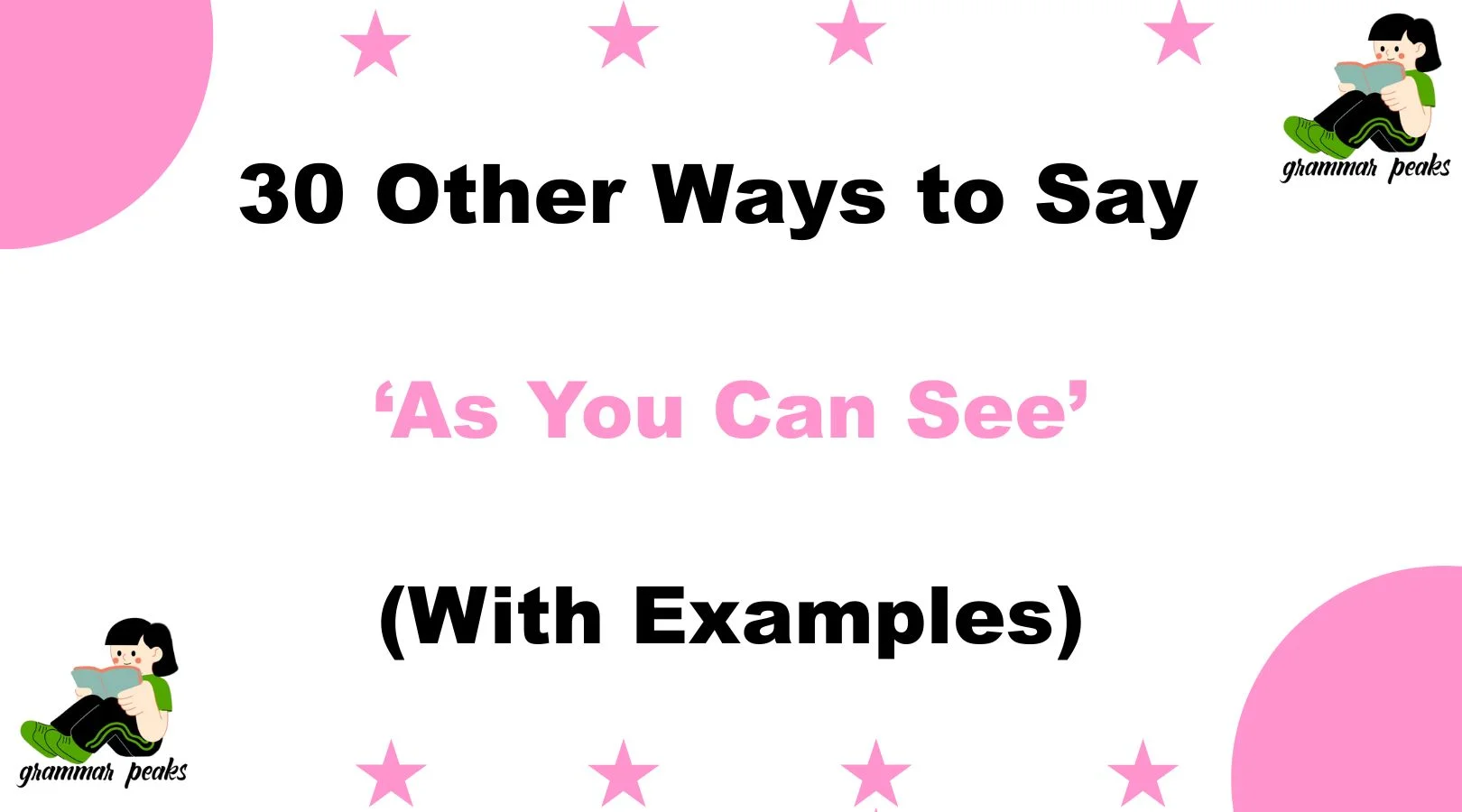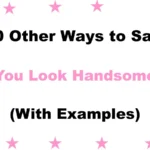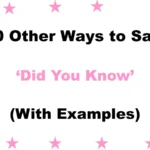Finding the right words to express a point clearly—and with warmth and care—is a gift in both writing and conversation. While “as you can see” is commonly used to guide someone’s attention, it can sometimes feel too formal, repetitive, or impersonal. Whether you’re preparing a presentation, writing an email, or connecting with someone on a deeper level, using the right alternative can make your message more thoughtful and effective.
In this article, you’ll discover 30 empathetic, clear, and professional alternatives to say “as you can see,” each with examples, tone guidance, and best/worst usage tips—so you can connect more meaningfully, whether at work or in everyday conversations.
What Does “As You Can See” Mean?
“As you can see” is a common phrase used to draw someone’s attention to something that should be obvious or has just been explained or shown. It’s often used in presentations, emails, or written explanations to highlight a point, emphasise visual data, or guide the reader toward a specific conclusion.
While the phrase serves a functional role in communication, it can sometimes come across as overly formal, repetitive, or even unintentionally condescending—especially if the point being made isn’t as clear as implied.
When to Use “As You Can See”
Use this phrase when you need to gently direct someone’s attention to a point that should be obvious or recently presented—especially in professional or instructional contexts. It’s suitable for presentations, documents, reports, or even casual explanations when you’re referring to something just shared.
Is It Professional/Polite to Say “As You Can See”?
Yes, but with caution. While “as you can see” is grammatically correct and commonly accepted, overusing it or using it in the wrong tone may make your communication sound patronizing or overly obvious. Consider swapping it out with alternatives that feel warmer, more natural, or audience-sensitive.
Pros and Cons
Pros:
- Directs attention effectively
- Easy to understand
- Works in both spoken and written formats
Cons:
- Can sound overly obvious
- May feel impersonal or too formal
- Loses meaning if used too frequently
Synonyms for “As You Can See”
1. Clearly
2. As shown here
3. Evidently
4. As demonstrated
5. This shows that
6. Notice that
7. As illustrated
8. From this, it’s clear
9. Obviously
10. Looking at this
11. It’s apparent that
12. Based on this
13. As indicated
14. As revealed
15. You’ll observe that
16. This indicates
17. It’s easy to see that
18. From the data
19. Take note of
20. It’s visible that
21. This confirms that
22. You’ll notice
23. As reflected here
24. Observe that
25. You can tell that
26. In light of this
27. As it turns out
28. What this shows
29. It’s quite evident
30. This makes it clear
1. Clearly
Definition: Used to express something that is unmistakable or without doubt.
Detailed Explanation: “Clearly” is a concise, strong way to indicate that something is obvious or easily understood, especially after presenting facts or visuals.
Scenario Example: “Clearly, our new marketing strategy is working.”
Best Use: To reinforce a strong point backed by data or logical flow.
Worst Use: When used to dismiss someone’s perspective (e.g., “Clearly, you don’t understand”).
Tone: Assertive but can be warm if used with care.
2. As shown here
Definition: Points to something being visually or contextually demonstrated.
Detailed Explanation: This is ideal when referencing a graph, image, or example in close proximity.
Scenario Example: “As shown here, engagement doubled within a week.”
Best Use: When a visual accompanies your explanation.
Worst Use: In situations with no visual aid—this weakens clarity.
Tone: Professional, supportive, and neutral.
3. Evidently
Definition: Means clearly or obviously based on the facts or appearance.
Detailed Explanation: “Evidently” suggests that evidence speaks for itself and doesn’t require further explanation.
Scenario Example: “Evidently, customer satisfaction improved.”
Best Use: In reports or formal analysis.
Worst Use: May sound overly detached or cold in emotional topics.
Tone: Formal, analytical.
4. As demonstrated
Definition: Refers to something that has just been shown or explained.
Detailed Explanation: Helpful for guiding attention to preceding proof or results.
Scenario Example: “As demonstrated, the new workflow saves time.”
Best Use: After hands-on or technical explanations.
Worst Use: If nothing has actually been shown prior.
Tone: Confident, educational.
5. This shows that
Definition: Connects a demonstrated result with a clear conclusion.
Detailed Explanation: It’s a natural way to guide someone from observation to insight.
Scenario Example: “This shows that consistency pays off.”
Best Use: In persuasive writing or storytelling.
Worst Use: When conclusions are not strongly backed by evidence.
Tone: Friendly, conversational.
6. Notice that
Definition: A gentle prompt to observe or pay attention to something specific.
Detailed Explanation: “Notice that” feels more inviting than commanding, making it a great phrase in conversational or instructional settings.
Scenario Example: “Notice that the colors gradually shift as we move across the design.”
Best Use: When explaining details in tutorials or walkthroughs.
Worst Use: If overused, it may sound like a lecture.
Tone: Warm, instructional.
7. As illustrated
Definition: Refers to something that’s been represented visually or figuratively.
Detailed Explanation: Useful for connecting illustrations, examples, or diagrams with a key point.
Scenario Example: “As illustrated, the process is both quick and effective.”
Best Use: When there’s a clear supporting image, chart, or example.
Worst Use: In purely verbal or text-based communication with no illustration.
Tone: Professional, clear.
8. From this, it’s clear
Definition: Introduces a conclusion based on something that’s just been presented.
Detailed Explanation: Combines observation and deduction, helping to guide the reader gently to a conclusion.
Scenario Example: “From this, it’s clear the team met all the deadlines.”
Best Use: When summarizing data, events, or cause-and-effect outcomes.
Worst Use: When what’s presented is still ambiguous or open to interpretation.
Tone: Calm, reflective.
9. Obviously
Definition: Used to stress that something should be easily understood or self-evident.
Detailed Explanation: Can help drive home a point, but must be used delicately—it might imply that the listener missed something simple.
Scenario Example: “Obviously, the results speak for themselves.”
Best Use: When summarizing very clear findings.
Worst Use: When there’s any risk of sounding sarcastic or dismissive.
Tone: Assertive, but potentially sharp.
10. Looking at this
Definition: Directs attention to a specific visual, detail, or moment.
Detailed Explanation: Creates an easy transition from evidence to insight, often used in live explanations.
Scenario Example: “Looking at this, we can understand why the change happened.”
Best Use: During presentations or visual walkthroughs.
Worst Use: If the visual reference is vague or not clearly accessible.
Tone: Conversational, helpful.
11. It’s apparent that
Definition: Indicates something is plain to see or understand.
Detailed Explanation: A formal yet polite way to draw attention to a clear outcome or trend.
Scenario Example: “It’s apparent that customer trust has improved.”
Best Use: In formal reports or analysis.
Worst Use: Can sound aloof or impersonal if overused.
Tone: Professional, objective.
12. Based on this
Definition: Used to draw conclusions from data or previously stated information.
Detailed Explanation: A clean transition that helps guide logic from point A to point B.
Scenario Example: “Based on this, we know our outreach strategy is working.”
Best Use: To lead into conclusions or actions.
Worst Use: When there is no strong “this” to support the logic.
Tone: Logical, matter-of-fact.
13. As indicated
Definition: Highlights something already pointed out or signposted.
Detailed Explanation: Very common in reports, emails, and documentation, often following references or data.
Scenario Example: “As indicated in the previous chart, sales spiked in March.”
Best Use: When referencing earlier data or statements.
Worst Use: If overused, it may feel repetitive.
Tone: Neutral, formal.
14. As revealed
Definition: Suggests that something has been uncovered or shown.
Detailed Explanation: Adds a layer of discovery, useful for storytelling or revealing trends.
Scenario Example: “As revealed by customer feedback, the design needs improvement.”
Best Use: When discussing new findings or insights.
Worst Use: May sound overly dramatic if the content is minor.
Tone: Reflective, insightful.
15. You’ll observe that
Definition: A polite, observant cue encouraging someone to notice something themselves.
Detailed Explanation: Often used in formal communication, it keeps the tone respectful and observant.
Scenario Example: “You’ll observe that our tone of voice remained consistent.”
Best Use: In lectures or polite instructional content.
Worst Use: In casual settings—it can sound stiff.
Tone: Formal, courteous.
16. This indicates
Definition: A signal that something points to or suggests a conclusion.
Detailed Explanation: Very commonly used in academic or business writing to link evidence to a logical point.
Scenario Example: “This indicates that our efforts are paying off.”
Best Use: When explaining cause-effect or research findings.
Worst Use: If used without strong supporting evidence.
Tone: Professional, analytical.
17. It’s easy to see that
Definition: A gentle prompt to guide someone toward an obvious observation.
Detailed Explanation: More conversational than “clearly” or “obviously,” and a bit more inviting.
Scenario Example: “It’s easy to see that the colors enhance readability.”
Best Use: In visual or UX discussions.
Worst Use: Could be seen as talking down if used with strong emphasis.
Tone: Friendly, relaxed.
18. From the data
Definition: Indicates a point derived specifically from statistics, charts, or factual sources.
Detailed Explanation: Highlights that the conclusion is evidence-based.
Scenario Example: “From the data, we know user retention improved.”
Best Use: In presentations and reports where numbers are central.
Worst Use: If there’s no actual data to back the claim.
Tone: Objective, evidence-driven.
19. Take note of
Definition: A gentle instruction to pay attention to something important.
Detailed Explanation: More proactive than “notice,” with a bit more authority behind it.
Scenario Example: “Take note of the improvement in user reviews.”
Best Use: In tutorials, demos, or when highlighting key details.
Worst Use: Can sound too commanding in casual writing.
Tone: Instructive, polite.
20. It’s visible that
Definition: Used to state something that is clearly observable.
Detailed Explanation: Especially relevant when referencing designs, images, or results.
Scenario Example: “It’s visible that traffic increased after the redesign.”
Best Use: In discussions that involve visual elements.
Worst Use: If referring to non-visual information.
Tone: Neutral, observational.
21. This confirms that
Definition: Used to validate or reinforce a previous point or finding.
Detailed Explanation: Often found in analytical or reflective writing, where evidence supports a claim.
Scenario Example: “This confirms that our assumptions were correct.”
Best Use: In reports, presentations, and analysis.
Worst Use: When used without evidence, it feels presumptive.
Tone: Strong, definitive.
22. You’ll notice
Definition: An inviting way to lead someone to observe or focus on something.
Detailed Explanation: Much more gentle and conversational than “look” or “clearly.”
Scenario Example: “You’ll notice the theme remains consistent throughout.”
Best Use: In emails, presentations, or soft guidance.
Worst Use: May sound too passive if emphasis is needed.
Tone: Friendly, helpful.
23. As reflected here
Definition: Connects your point to visual or contextual evidence.
Detailed Explanation: Great for reinforcing a concept using supporting material.
Scenario Example: “As reflected here, user feedback trends upward.”
Best Use: In visual or analytical breakdowns.
Worst Use: When no real reflection (evidence) exists.
Tone: Neutral, polished.
24. Observe that
Definition: Encourages someone to pay close attention to a specific point.
Detailed Explanation: More formal and often used in academic or scientific contexts.
Scenario Example: “Observe that the temperatures drop significantly.”
Best Use: In documentation or detailed walkthroughs.
Worst Use: May feel too commanding in casual communication.
Tone: Formal, directive.
25. You can tell that
Definition: A relaxed and natural way of pointing out something clearly evident.
Detailed Explanation: Great for storytelling or causal explanation with a human touch.
Scenario Example: “You can tell that the team worked really hard on this.”
Best Use: In conversations, casual writing, or heartfelt observations.
Worst Use: In technical or formal settings—it may lack authority.
Tone: Warm, informal.
26. In light of this
Definition: Means “considering this information” or “because of what has just been presented.”
Detailed Explanation: It bridges previous context to a new realization or decision, often used to express thoughtful reasoning.
Scenario Example: “In light of this, we’ll be adjusting our launch timeline.”
Best Use: In strategic discussions or when drawing conclusions from events or results.
Worst Use: Too vague without prior clear context.
Tone: Professional, reflective.
27. As it turns out
Definition: Introduces a surprising or clarified result that differs from expectations.
Detailed Explanation: Carries a conversational tone that fits storytelling or reflective writing, often with a twist.
Scenario Example: “As it turns out, the simplest solution worked best.”
Best Use: When describing unfolding events or soft conclusions.
Worst Use: In formal reports—it may sound too casual.
Tone: Conversational, narrative.
28. What this shows
Definition: Links evidence or demonstration to a clear interpretation or takeaway.
Detailed Explanation: Great for drawing attention to the meaning behind the data or visuals.
Scenario Example: “What this shows is the importance of consistent branding.”
Best Use: In persuasive writing or presentations.
Worst Use: If the supporting material is unclear or weak.
Tone: Clear, purposeful.
29. It’s quite evident
Definition: Stresses that something is very obvious or undeniable.
Detailed Explanation: More empathic than “it’s clear,” and can feel slightly dramatic when stating a strong point.
Scenario Example: “It’s quite evident that the redesign improved engagement.”
Best Use: When the results are striking and can stand on their own.
Worst Use: May sound dramatic if overused or unsupported.
Tone: Assertive, formal.
30. This makes it clear
Definition: A closing phrase that solidifies a previous point, making sure the conclusion is understood.
Detailed Explanation: Often used to end a section or argument with confidence and finality.
Scenario Example: “This makes it clear that customer experience is our top priority.”
Best Use: At the end of arguments, explanations, or data summaries.
Worst Use: If placed too early in a discussion, it may feel rushed.
Tone: Conclusive, confident.
Conclusion
Choosing the right alternative to “as you can see” can help you sound more thoughtful, clear, and in tune with your audience. Whether you’re writing a formal report, guiding someone through a design, or casually explaining a concept, these phrases give you the flexibility to connect more personally and professionally.
Each expression carries its own tone, purpose, and context, so by choosing wisely, you can elevate your communication in a way that resonates better with readers and listeners. Words matter—and with the right ones, your message becomes not only understood, but remembered.
FAQs
1.What is a better way to say “as you can see” in a presentation?
Try using “as shown here,” “this demonstrates,” or “notice that.” These are clear, respectful, and appropriate for visual guides or slides.
2.Is “as you can see” rude or unprofessional?
Not necessarily, but it can feel condescending if overused or said with the wrong tone. Using softer or more inclusive alternatives helps maintain politeness.
3.What’s the most polite alternative?
Phrases like “you’ll notice,” “as illustrated,” or “from this, it’s clear” strike a perfect balance of respect, clarity, and professionalism.
4.Can I use these alternatives in formal writing?
Absolutely. Options like “evidently,” “as indicated,” “based on this,” and “this confirms that” are especially well-suited for reports, academic writing, and emails.
5.Do any of these work for storytelling or casual tone?
Yes! Use “as it turns out,” “you can tell that,” or “in light of this” for more relaxed, narrative-based communication.






